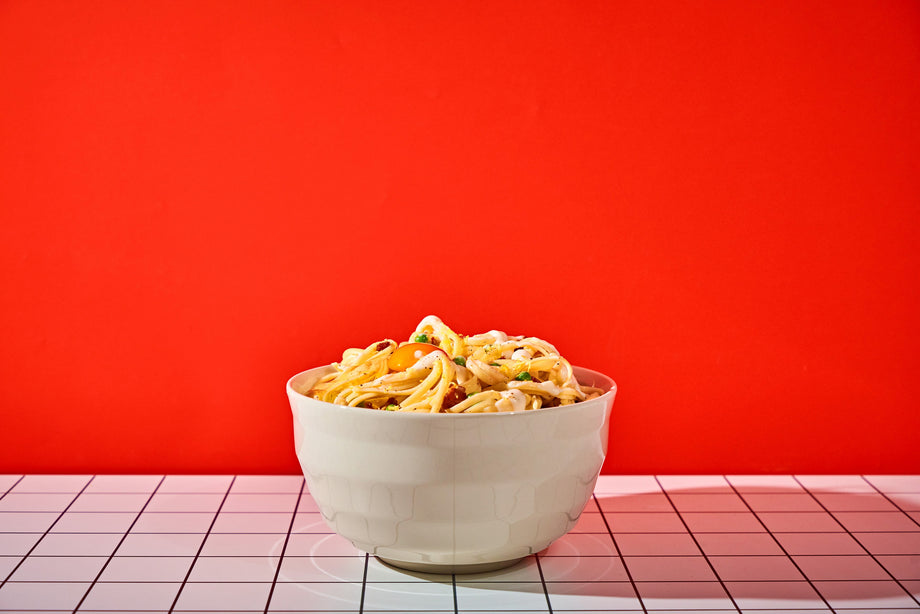8 of the Best Low-Carb Pasta Noodles to Try
Written by: Lucian Campan
Published on: April 23, 2025
Whether you’re following a keto diet, managing your blood sugar, or simply seeking nutritious meal alternatives, there are low carb pasta options for everyone. From high-protein durum wheat to shirataki to edamame noodles, here are our top picks that are both satisfying and nutritious.
8 of the Best Low-Carb Pasta Noodles
In our journey toward crafting the perfect high protein low carb pasta, we taste-tested every kind of noodle out there and continue to stay on top of what’s new and popular in the market. Here are the best low carb pasta alternatives to traditional noodles that we’ve found.
1. Pete’s Pasta High-Protein, Low-Carb Noodles
Made from a blend of durum wheat semolina and added plant-based proteins, Pete’s Pasta’s low-carb noodles pack 17 g of protein and just 7 g of carbs.
Unlike many alternatives, these noodles also deliver a texture and bite that closely mirrors conventional pasta, which means you don’t have to make compromises. It also performs beautifully with classic sauces like marinara, alfredo, or pesto, and holds up well in both hot dishes and cold pasta salads.
2. Shirataki Noodles
Shirataki noodles originate from the root of the konjac plant and are composed of glucomannan, a specific type of fiber. These translucent noodles provide a zero-carb solution if you’re a pasta lover in search of a lightweight alternative.
Because shirataki noodles consist of 97% water and 3% glucomannan fiber, they contain virtually no digestible carbohydrates. Their low-calorie profile makes them ideal for weight management and ketogenic diets.
3. Hearts of Palm Noodles
From the cores of palm trees, hearts of palm noodles offer a mild taste and distinctive al dente texture. With few carbohydrates and a low amount of calories per serving, their adaptable nature allows you to incorporate them into a wide variety of dishes.
Hearts of palm noodles pair well with both light and creamy sauces. And it’s possible to find options that are gluten-free, sugar-free, and non-GMO.
4. Edamame and Black Bean Pasta
Edamame and black bean pasta deliver a one-two punch of both protein and fiber, significantly surpassing what traditional wheat-based options contain. These nutrient-dense alternatives are good for supporting your muscle development and digestive health.
In general, legume-based pasta provides robust flavor and a satisfying texture that closely mimics traditional pasta, making it excellent if you’re a health-conscious consumer. However, some legume-based noodles like edamame or yellow pea (such as ZENB pasta), or chickpea and lentil (such as Barilla Protein+ pasta), can carry an earthy flavor or softer texture depending on how you prepare it — something to consider for picky eaters or traditional pasta fans.
5. Zucchini Noodles (Zoodles)
Zucchini noodles are a fresh, vegetable-based alternative with minimal carbohydrate content. Simple spiralizing techniques with a kitchen tool can transform your zucchini into a versatile, nutritious noodle substitute.
While nutritious and refreshing, these options don’t fully replicate traditional pasta texture and often require moisture control techniques to avoid sogginess. In other words, your results will be better if you squeeze any excess moisture out of the zoodles before cooking them. But their light, crisp texture also makes zucchini noodles perfect for cold salads in addition to hot entrées.
6. Spaghetti Squash
Spaghetti squash provides a naturally sweet, low-carbohydrate pasta alternative with a unique, strand-like texture. Roasting the gourd reveals delicate, noodle-like strands that you can use in just about any recipe. The subtle sweetness of spaghetti squash pairs exceptionally well with robust tomato sauces, creating satisfying and nutritious meals.
However, similar to zoodles, you will want to remove as much moisture as possible from the spaghetti squash beforehand to avoid watering down your sauces or ending up with a soggy spaghetti squash casserole. If you want a little crisp in your dish, it’s especially important that your spaghetti squash noodles are mostly dry.
7. Cauliflower-Based Pasta
Many cauliflower pasta recipes also incorporate alternative flours to further enhance the pasta’s texture and nutritional value. These recipes can produce something that resembles a traditional pasta experience but delivers significantly more nutritional value. Try pairing cauliflower-based pasta with rich, creamy sauces.
8. Lupini Bean-Based Pasta
A lupini bean-based pasta, such as Kaizen pasta, offers up a significant amount of protein and only a handful of net carbs per serving. It mimics traditional pasta well and is ideal for both keto and fitness-conscious eaters. Additionally, its ingredient list is clean and minimal — just four main ingredients, including lupini flour and fava bean protein.
How Low-Carb Pasta Differs From Traditional Pasta
Low-carb pasta typically has fewer net carbs and higher fiber and protein content when you compare it to traditional pasta. Innovative low-carb pasta may also incorporate diverse ingredient sources, such as:
-
Chickpea-based formulations (such as Banza pasta)
-
Vegetable spirals
-
Shirataki noodles
-
Bean-derived pasta options
-
Squash and edamame compositions
Benefits of Low-Carb Pasta Noodles
If you’re a health-conscious consumer, low-carb pasta noodles can offer you a tasty alternative to traditional high-carb pasta. They make it possible to manage your dietary goals without sacrificing anything in the way of taste or culinary experience. Here are the major benefits we’ve identified after poring through the research.
Support for Low-Carb and Keto Diet Goals
Low-carb pasta enables you to maintain ketogenic and low-carbohydrate eating patterns by satisfying the reduced carbohydrate content requirement (5-10 grams per serving) while still being a satisfying meal. This can help support any weight management objectives you might have, too.
Management of Blood Sugar Levels
If you’re looking to improve your blood sugar regulation, a low-carb pasta may fit nicely into your diet. By reducing your carbs and keeping your blood sugar even, you also lower your triglyceride levels and enhance your insulin sensitivity. For these reasons, low-carb pasta and other low-carb foods can be an important part of the management strategy for someone with type 2 diabetes.
How to Choose the Best Low-Carb Pasta
Selecting the ideal low-carb pasta requires careful consideration of your dietary goals and culinary preferences. Keep the following tips in mind.
Consider the Texture and Flavor
When evaluating low-carb pasta options, texture and flavor are obvious considerations. A low-carb, high-protein durum wheat semolina pasta, such as Pete’s Pasta or Carbe Diem Low-Carb Pasta will be most similar in taste to traditional pasta. Shirataki noodles also offer a neutral taste, with 0 g net carbs per serving and a unique gelatinous texture. On the other hand, edamame spaghetti has a firmer texture and a distinct bean flavor.
Look at the Ingredients and Nutrition
If the nutritional profile is important to you, you’ll want to read the ingredient labels carefully. We recommend looking for a pasta with at least 20 g of protein per serving, at least 10 g of fiber, and a low net carb count (under 10 g).
Keep in mind that some high-fiber pastas may contain up to 24 g of fiber per serving. While this can do wonders to increase your satiety and manage your blood sugar control, it may cause digestive discomfort if you’re not accustomed to a high-fiber diet in advance. Start with small servings to assess your tolerance, and then work your way up to a full serving if all goes well and as your body acclimates.
Match the Pasta Type to the Recipe
There are so many kinds of pasta out there. Different pasta shapes work well with different sauces, so sometimes you may want to let the recipe dictate which pasta you choose. For example:
-
Zucchini noodles are ideal for light, fresh sauces.
-
Hearts of palm pasta is perfect for creamy, rich dishes.
-
Shirataki noodles work best for Asian-inspired recipes.
-
Edamame pasta is great for protein-packed pasta meals.
3 Tips for Cooking Low-Carb Pasta Noodles
Preparing low-carb pasta requires specific techniques to ensure optimal texture and flavor. Follow these tips to master the cooking process for these alternative noodles.
1. Use a Large Pot and Salted Water
High-protein, low-carb pasta made from durum semolina wheat and enriched with legumes or egg whites cooks differently than traditional pasta. To prevent sticking and ensure even cooking, use a large pot of well-salted boiling water. Stir frequently in the first few minutes to help maintain the pasta’s shape and prevent clumping.
2. Rinse Shirataki Noodles First
Eliminate the distinctive shirataki noodle smell by thoroughly rinsing them under cold water for 2-3 minutes. Pat the noodles completely dry using paper towels to remove excess moisture. This process removes the natural konjac root aroma and prepares the noodles to absorb sauce.
3. Avoid Overcooking
Vegetable-based pasta alternatives like hearts of palm require gentle cooking. Cook them for 1-2 minutes maximum. The high heat and minimal cooking time prevents water release and mushiness. For zucchini noodles, consider quickly sautéing them instead of boiling them to control the moisture and retain a firm consistency.
4. Choose Hearty Sauces
Because many low-carb pastas have a neutral or mild flavor, pairing them with rich, flavorful sauces enhances the overall dish. Think creamy pesto, tomato-based meat sauces, or spicy arrabbiata. These pairings not only improve the taste of the dish but also help increase your satiety — especially important if you’re following a low-carb or high-protein diet.
Frequently Asked Questions
What is low-carb pasta?
Low-carb pasta is a healthier alternative to traditional wheat pasta. It consists of durum wheat semolina, konjac root, vegetables, legumes, or alternative flours. Low-carb pasta is for people following ketogenic, low-carb, or health-conscious diets who want to enjoy pasta without excessive carbohydrate intake.
How many carbs are in low-carb pasta?
Low-carb pasta typically contains 3-10 grams of net carbs per serving, compared to traditional wheat pasta, which has 40-50 grams. The exact carb count depends on the base ingredient.
Are low-carb pastas healthy?
Low-carb pasta is generally healthier than traditional pasta. It offers higher protein, increased fiber, and lower net carbohydrates.
Can I eat low-carb pasta on keto?
Yes, low-carb pasta is keto-friendly. Always check nutritional labels and portion sizes to ensure they fit within your daily carbohydrate limits for maintaining ketosis.
How do I cook low-carb pasta?
Cooking low-carb pasta varies by type. Always follow the package instructions and avoid overcooking to maintain the desired texture and prevent mushiness.
Which low-carb pasta tastes most like traditional pasta?
The closest match depends on your personal preferences and the specific recipe you're preparing. However, the high-protein, low-carb pasta by Pete’s Pasta, which incorporates a high-protein, low-carb durum wheat semolina, objectively tastes very similar to traditional pasta.
What sauces work best with low-carb pasta?
Cream-based pesto and olive oil sauces work well with low-carb pasta. Avoid heavy, sugar-laden sauces. Consider making homemade sauces to further control the carbohydrate content of each meal.
Are low-carb pastas more expensive?
Low-carb pasta is generally more expensive than traditional wheat pasta, ranging from $3-$8 per package compared to $1-$3 for regular pasta. However, the higher cost reflects the specialized ingredients, unique production processes, and nutritional benefits.


